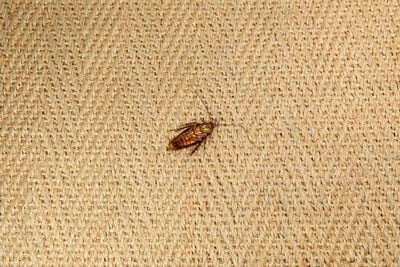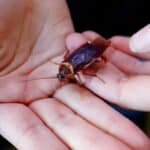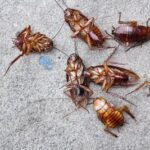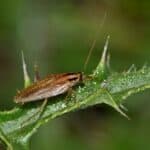If you think you’ve seen cockroaches walking on your carpet, it’s natural to feel concerned. Cockroaches build nests in out-of-the-way locations, and the underside of a carpet may seem like a vulnerable location. That’s especially true if the carpet is bunched up, worn out, damp, and covered in food crumbs.
Cockroaches can live in, under, and around carpets. That’s because carpets contain crumbs, skin flakes, hair, spilled juices, and other organic waste. Your carpet is most at risk when it’s damp, dirty, near a wall/corner or other furniture, sees little foot traffic, or has several access points underneath it.
Most cockroaches won’t form a nest under a carpet. Instead, they’ll select somewhere nearby and use the carpet as a scavenging spot. They may also lay their eggs there, where the new hatchlings will enjoy food, shelter, and safety. However, it may be that you’ve observed other insects on the carpet, such as carpet beetles.
Can Roaches Live Under Carpet?
Cockroaches sometimes live in and under carpets, especially if they meet these requirements:
- Dark
- Damp
- Contain food debris
- Little human traffic
Carpets will be more attractive to cockroaches when they contain dropped food sources. As stated, food crumbs, skin flakes, hair, and residue from spilled drinks can serve as meals to cockroaches.
Most people who see a cockroach have observed one traveling from its nest to another location for sustenance.
Do Cockroaches Lay Eggs in Carpet?
Cockroaches will sometimes lay their eggs in carpets, although never in the open to avoid human detection.
They may hide their eggs under a neglected rug or in the tight edges where the carpet meets the wall. If the carpet is near furniture, they’ll have additional places to conceal their egg sacks (ootheca).
Female cockroaches sometimes lay their eggs in little-used areas of carpets that are hidden by furniture and other household items. When they hatch, the nymphs feed on crumbs and debris and stay warm in the soft carpet fibers.
Some carpets are well placed to serve as nesting places for cockroaches. They’re warm (depending on the type and thickness) and are near walls. Since most people won’t lift their carpets, cockroaches can find a dark area to hide.
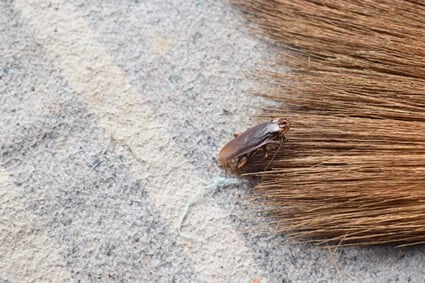
Do Cockroaches Like Carpets?
Cockroaches prefer unkempt carpets as they often contain food. That’s true of non-traditional food as well, beyond crumbs and spills. Cockroaches can enjoy a meal of any organic waste, including pet droppings, skin flakes, and hair.
These pests will run up and down floor carpets. The fibers provide a solid grip for them to move quickly. When they sense danger, they’ll scamper into hiding spots underneath the carpet or inside home furniture.
According to the Journal of Experimental Biology, their antennae are powerful enough to estimate distances and locate predators. Cockroaches love to stay near their hiding spots as it keeps them safe from harm.
Cockroaches rarely seek out carpets as a nesting place, even if they’re willing to spend time on and under carpets. However, carpets lack the space to form a colony, see too much activity, and are near better nesting locations.
Your carpeted area may have large appliances, cardboard storage boxes, or wall gaps a short distance away. These are more ideal, so cockroaches will form a permanent home nearby.
You may have your carpeting stapled down, making it harder for cockroaches to find an access point. If you regularly vacuum your carpets, this activity and lack of food will make them far less appealing.
Cockroaches prefer a dirty carpet, preferably one that’s bunched up, damaged, sees little traffic, and is damp. They may use it as a permanent home, but more commonly as a favored hiding spot or a good foraging locale.
How Do You Know If Your Carpet Has Roaches?
If you have cockroaches hiding in your carpet, it may slip your notice until a colony has formed. To prevent a full infestation or find a nest, you should check for signs of their presence.
While hard to see during the day, cockroaches leave evidence behind if you look closely enough. Here are the signs of a cockroach infestation in your carpet:
Droppings
Cockroaches leave their droppings everywhere. If they frequent your carpet, they’ll poop all over it. The droppings are dark, resembling black pepper or ground coffee. They’ll be cylindrical and thin, albeit of varying lengths.
Eggs
Cockroach eggs are contained within an ootheca, which is capsule-shaped. This egg sac is often black or brown and has distinct lines running along its sides.
When inspecting your carpet, look at its surface and its underside for egg sacs. If you spot any, an infestation is forming quickly. If you notice several, you have a short amount of time to act.
Shed Skin
Cockroaches molt about 5-8 times in their lifespan. Shedding their skin allows them to progress through their developmental stages and reach their full sizes. Because most cockroaches don’t live beyond 1 year, you should find many shed skins lying around.
Do Cockroaches Eat Carpet?
Under normal circumstances, cockroaches won’t eat your carpeting. They only resort to eating fabrics when there are no other food sources available.
They’ll also eat fruits and vegetables, alongside meat. This makes leftovers the prime target of cockroaches, followed by organic waste like hair or pet poop. They can also eat things derived from organic matter because paper and cardboard are made from plant fibers.
Although some carpet fibers are made from organic materials, most are synthetic. This makes them unappealing to cockroaches. For those made from real fabric, they’re edible to cockroaches.
A starving cockroach will be less fussy. If you have an infestation and have eliminated all other food, the cockroaches may start chewing on your carpet out of desperation.
However, it’s still more likely for the cockroaches to target any food and drink spills in carpets. Unless you’re vacuuming every day, or several times a day, cockroaches will be able to find hair, dust, or skin flakes to eat.
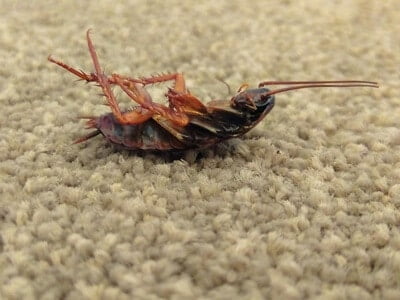
How to Get Rid of Cockroaches in Carpet
You likely won’t see cockroaches hiding underneath your carpets and rugs. If they’re living under carpeted flooring, you’ll rarely see them. However, cockroaches are most likely to emerge at night than during the day.
Cockroach eggs are mostly brown or black, shaped like pills. Some species, like the Oriental cockroach, have longer eggs, measuring around 12 mm (0.5 inches). Others, such as German cockroaches and American cockroaches, have smaller eggs, measuring around 8 mm (0.33 inches) in length.
Once you identify the areas where they hide their eggs, you can get rid of cockroaches and their eggs in these ways:
Vacuum Cleaning
You can vacuum up the cockroach eggs. This won’t take much time and can cleanly remove the ootheca. Most vacuum cleaners won’t kill the eggs, but you can remove them from your home.
Boric Acid
Boric acid is toxic to cockroaches. It works well because cockroaches eat their dead, thus poisoning other members of the colony. Sprinkle some boric acid, in powder form, in areas that cockroaches most commonly use.
Insect Growth Regulators (IGR)
IGR’s specifically to exterminate annoying pests like cockroaches. Most IGR’s are designed to interfere with the molting process. This will affect a cockroach’s ability to reproduce, as well as kill the already-formed eggs.
Baking Soda And Sugar
In a cup or bowl, mix baking soda and sugar in a 1:1 ratio. After that, sprinkle the mixture in all the places you suspect the cockroaches may hide, even if it’s on the carpet. The sugar will act as bait, while the baking soda kills the cockroach as it swells up inside them.
Diatomaceous Earth
Its main chemical component, marine phytoplankton, is a dehydrating agent. This means it can dry the exoskeleton of cockroaches, leading to dehydration. It is best sprinkled around the places where the cockroaches build their nests.
It’s crucial to tidy up all food crumbs and clean up spills immediately after they make contact with the floor. Vacuum the carpet at least once a week. Subsequently, lift it up to spray and vacuum the floor underneath.
